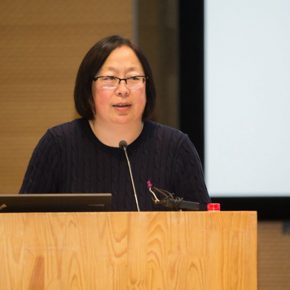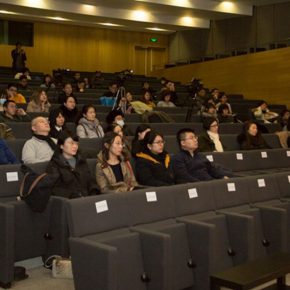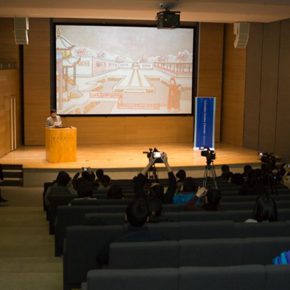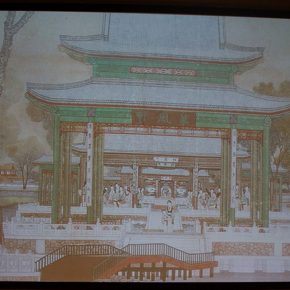
On January 9, 2017, the lecture of “‘Dream of Red Mansions’: Peepshow and Images of Grand View Garden” was held in the Auditorium of CAFA Art Museum. The lecture was hosted by Prof. Song Xiaoxia from the School of Humanities, CAFA also invited was Shang Wei, Du Family Professor of Chinese Culture in the Department of Eastern Asian Languages and Cultures, Columbia University as the speaker, Shang’s research focuses on the novels and dramas of the Ming and Qing Dynasties, which involve the fields of intellectual history, cultural history, publishing culture and the history of reading.
First of all, Prof. Song Xiaoxia delivered a speech to start the lecture, she said that, the academic research on the “Dream of Red Mansions” has been very deep, but there were few studies on the various discourses, performances and especially the visual forms derived from the “Dream of Red Mansions”. Prof. Shang was not only concerned with the interior visual space but also took the “Dream of Red Mansions” as the focal point of an era, to reflect the social and cultural changes, especially the changes in taste and fashion.
Many images of the Grand View Garden of the 18th and 19th century were drawn using the visual tool of “peepshow”. How was the Grand View Garden in the “Dream of Red Mansions” portrayed as various images and in different forms of art? How was it influenced by the new visual technology of a peepshow? How do we form a new sense of space and vision? On the contrary, what new perspective does it offer us to understand the “Dream of Red Mansions”? With these questions, Prof. Shang Wei had his own analysis.
Grand View Garden is the residence of the main characters in the novel of “Dream of Red Mansions”, while it is also a projection of an unreal fantasy. It is “both the true and false, being true and false”. Prof. Shang showcased several restored images created by the descendants, because the “Grand View Garden” of the novel is shaped by the textual description, when the “Grand View Garden” is detached from the text of “Grand View Garden” and transformed into the presentation of visual art form, the distance and the proportion provided in the novel are inaccurate and almost impossible to be accurately recovered.
Then Prof. Shang showcased a pair of colored woodcut print illustrations of “Baoqin Standing in Snow” produced by “Dream of Red Mansions”, seen from this composition we can find that it was influenced by European paintings, “seen from the architectural style it was still an oriental garden, but actually? its spatial construction is entirely Western.”
In the Qing Dynasty there were many images displayed using the idea of a peepshow, in order to make the peepshow have a more effective perspective, these images were composed and drawn using the Western technology of perspective, and even sometimes modified the size and location of the things in reality in order to create the expected effect, or placing the characters depicted in the text of Chinese stories in the scenes of Western cities, it seems that all things are not for the “presentation of reality”, but serves the pursuit of an “exaggerated spatial depth”.
After that, Prof. Shang analyzed it centering it on the “Grand View Garden” of the Qing Dynasty as the main object. This set of work was purchased by the Museum of Chinese History from a Chinese painting and calligraphy shop located in the Inner Xuanwumen Avenue in 1955. The architectural style of the picture is of a lime, tile and timber structure of a gable and hip roof, but the pillars are of su shi architectural style, formed a special royal garden style that merges the Southern and Northern characters. The whole picture takes five different buildings including Hengwuyuan Garden, Tubi Villa, Liaofengxuan, Aujingguan, Mudan Pavilion as the centrepoint, to construct several different scenarios, while the vanishing points of all the pavilions, corridors and lanes intersect in the Liaofengxuan located in the center of the picture, and it crosses the two-storied building, to further impel the perspective depth. Lao Zi’s “Tao Te Ching” reads that: The way bears sensation, sensation bears memory, sensation and memory bear abstraction and abstraction bears the world. In the perspective, one dot is like – starting from a dot to form a line, starting from a line to form a thing – once there is a line, there is a thing, it is the use of the visual language of line to portray the universe, imagining the process as the birth of universe. Prof. Shang said that when this idea was applied in the interpretation of the Grand View Garden design, we can see that the visual center of the picture, namely the central vanishing point, is Jia Baoyu, Lin Daiyu, and the viewer look at each other from a distance. On the one hand, it represents the end of the space of Grand View Garden and on the other hand it also presents the gaze of two protagonists’.
Returning to the Grand View Garden figure, it shows the occasion of four feasts, delicately showing that we will find these scenes were from different chapters of the “Dream of Red Mansions”, it displays up to 137 people, including several key figures, such as Jia Baoyu, Lin Daiyu and Grandmother Jia who have appeared in different occasions in one picture and Jia Baoyu at least repeatedly appeared seven times in it. “This means that there are different scenes appearing in the space of one picture at the same time,” This approach can be said to cancel or suspend the time frame of the Grand View Garden – it is the so-called feature of “Paradise”. Then, whether this approach of Jia Baoyu’s “replication” has a relationship with the new visual technology at that time? Prof. Shang pointed out that the Western mirror was also known as the “Duobao mirror” at that time, one side is flat and another side is diamond-shaped, through the diamond-shaped mirror it is possible to see different images of the same object, it is hard to distinguish the truth and lies. Poet Yue Duan of the Qing dynasty called it the “multi-eye mirror”, and the “multiple eyes” were eventually boiled down to “multiple hearts” in a Buddhist context, It is because of “multiple hearts”, those phantoms are ultimately boiled down to a subjective illusion, people see the world that is an unreliable unreal world.
How did the Western visual mirror activate the Chinese Taoism and Buddhism-related discourse right after it entered China in the late Qing Dynasty? And how did it enter the Buddhism and Taoism which led to the discrimination to distinguish the truth and lies and mutually inspired and completed the era of new visual culture? Prof. Shang finally concluded that, “We know that the question of “whether it is truth or false” is an essential theme of the “Dream of Red Mansions” and through these analyses and discussions it is able have a new understanding of the contemporary and contemporaneity of the “Dream of Red Mansions” and the theme of “true and false”.
Text by Lin Jiabin, translated by Chen Peihua and edited by Sue/CAFA ART INFO
Photo by Hu Sichen/CAFA ART INFO





































